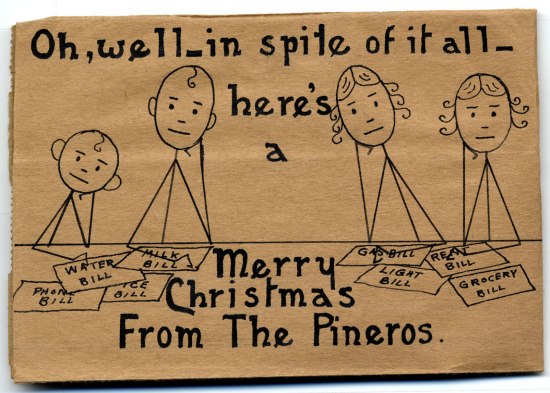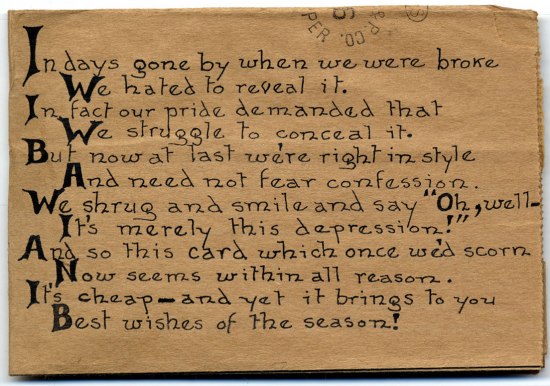

The Smithsonian sets the scene for this Christmas card sent in 1933, a few years into the Great Depression. They write:
Despite the glum economic situation, the Pinero family used a brown paper bag to fashion an inexpensive holiday greeting card. They penned a clever rhyme and added some charming line drawings of Mom, Dad, and the kids with the message: "Oh, well—in spite of it all—here's a Merry Christmas from the Pineros." On December 19, 1933, they mailed it from Chicago to friends in Massachusetts, using a one-and-a-half-cent stamp. For a minimal outlay of cash, they were able to keep in touch with friends and comment on their reduced circumstances with wit and humor.
This hand-lettered poem is a delightful example of light verse, a whimsical form of poetry intended to entertain or amuse, even if treating a serious subject in a humorous manner. In the poem, the Pineros suggest that they had struggled economically for some time, but now, due to the continuing Depression, others shared their financial plight, which enabled them to be more open and candid about their situation.
Like many families, the Pineros probably had lots of bills for necessities including rent, groceries, utilities, milk, and ice. Because not every family had electric refrigeration in 1933, many relied on regular deliveries of ice to keep their perishable foods cold. These bills for milk and ice were separate; they were not part of the grocery account. Local dairies supplied milk and other products on a daily basis. Both the Ice Man and the Milk Man would cometh, as long as they were paid!
It's a historical case of when less is indeed more...
Would you like to support the mission of Open Culture? Please consider making a donation to our site. It's hard to rely 100% on ads, and your contributions will help us continue providing the best free cultural and educational materials to learners everywhere.
Also consider following Open Culture on Facebook and Twitter and sharing intelligent media with your friends. Or sign up for our daily email and get a daily dose of Open Culture in your inbox.
Related Content:
When Salvador Dalí Created Christmas Cards That Were Too Avant Garde for Hallmark (1960)
John Waters Makes Handmade Christmas Cards, Says the “Whole Purpose of Life is Christmas”
Watch Terry Gilliam’s Animated Short, The Christmas Card (1968)
A Simple, Down-to-Earth Christmas Card from the Great Depression (1933) is a post from: Open Culture. Follow us on Facebook, Twitter, and Google Plus, or get our Daily Email. And don't miss our big collections of Free Online Courses, Free Online Movies, Free eBooks, Free Audio Books, Free Foreign Language Lessons, and MOOCs.
from Open Culture https://ift.tt/2rqzNCs
via Ilumina
Comments
Post a Comment